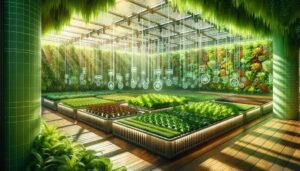Lettuce hydroponics involve growing lettuce in a nutrient-rich water solution using systems like NFT or DWC, which provide precise control of growing conditions to prevent root rot through effective aeration, proper pH, and temperature maintenance, ensuring healthy and rapid growth.
Ever wondered how to grow crisp, healthy lettuce using hydroponics? Starting with **lettuce** in hydroponic systems can be a game-changer, especially when using bins. But, the lurking issue of root rot might make you apprehensive. Let’s dive into setting up a system that enhances growth while effectively preventing potential pitfalls.
understanding hydroponic systems for lettuce
Hydroponic systems for lettuce offer a soil-free method to cultivate lush and fresh greens. These systems use a nutrient-rich water solution, providing plants with the necessary elements for growth directly through their roots. By eliminating soil, hydroponics reduces the risk of pests and soil-borne diseases, ensuring a cleaner growing environment.
Types of Hydroponic Systems
Different hydroponic systems can be effectively employed for growing lettuce, including Nutrient Film Technique (NFT), Deep Water Culture (DWC), and Aeroponics. NFT involves a continuous flow of nutrient solution over the plant roots, which optimizes nutrient uptake. DWC situates plant roots in directly oxygenated water, promoting robust growth. Aeroponics, meanwhile, mist roots with nutrient solution, facilitating air exposure for optimal hydration and oxygenation.
Benefits of Hydroponic Lettuce
Lettuce grown hydroponically can mature faster and yield higher crops compared to traditional soil farming. It facilitates year-round production, irrespective of seasonal changes, and utilizes less water due to recirculation techniques. The enhanced control over nutrients also allows for precise adjustments tailored to the plant’s specific growth stages, maximizing efficiency and output.
setting up effective hydroponic bins
Setting up effective hydroponic bins is crucial for cultivating healthy, vibrant lettuce. Start by selecting the right bins, ensuring they are opaque to block light that can encourage algae growth. Choose containers that are large enough to support full-grown lettuce plants and their roots.
Fill the bins with a nutrient-rich water solution tailored for lettuce growth. Ensure the solution is maintained at the proper pH level, around 5.5 to 6.5, as this range is optimal for nutrient absorption. Monitor the electrical conductivity (EC) to keep nutrient levels balanced. Regular checks prevent deficiencies and promote robust growth.
Implement an efficient aeration system, as oxygen is vital for the roots. Bubble stones or air pumps can be used to keep the solution oxygenated, preventing the roots from becoming drowned or suffocated.
If you are using a wick system, ensure capillary action is sufficient to deliver nutrients to each plant. Adjust the wick’s placement as necessary to improve efficiency.
Position the bins in an area where they receive adequate light. Use artificial grow lights if natural sunlight is insufficient, maintaining 12-16 hours of light daily. Keep the temperature consistent, ideally between 60-70°F for optimal lettuce growth.
common causes of root rot in lettuce
Root rot is a common issue in hydroponic lettuce systems that can severely affect plant health. It’s crucial to understand the main causes to prevent it. Overwatering stands out as a primary culprit, as excessive moisture can deprive roots of oxygen, leading to decay. Ensure proper drainage and aeration in your system.
Poor hygiene in hydroponic setups can also promote root rot. Bacteria and fungi thrive in unclean environments. Regular cleaning of the bins and equipment with antiseptics helps to minimize microbial growth. Inspect and sanitize all components before introducing them into your system.
Another factor is an imbalanced nutrient solution. High concentrations can burn the roots, while deficiencies weaken them, both increasing susceptibility to rot. Regularly monitor and adjust nutrient levels based on the plant’s developmental stage.
Avoid excess heat as it can impact the water temperature, leading to conditions favoring pathogens. Maintain water at a cool yet optimal temperature, ideally between 60-70°F. This ensures sufficient dissolved oxygen, keeping roots healthy.
preventive measures for root rot
Preventing root rot in your hydroponic lettuce setup involves several key strategies. Start by ensuring proper aeration to maintain healthy roots. Use air pumps to oxygenate the water, preventing roots from suffocating. Regularly inspect your system for clogging to ensure consistent water flow.
Maintain a clean environment to reduce pathogen risks. Regularly clean bins and tools with a mild disinfectant. This helps keep bacteria and fungi at bay. Avoid reusing old growing media without sanitizing it first.
Monitor the pH levels and adjust the nutrient solution consistently. An imbalance can lead to stress, making plants susceptible to root rot. Strive to keep the pH between 5.5 and 6.5, checking and adjusting weekly or as needed.
Consider using beneficial microbes, such as mycorrhizae, which can enhance root health. These microbes form protective barriers and promote nutrient uptake but should be introduced at early growth stages for effectiveness.
Keep water temperatures in check, aiming for a range of 60-70°F. Use water chillers if necessary, especially in warmer climates, to prevent the growth of pathogens like Pythium, which thrive in warmer conditions.
maintaining ideal conditions for lettuce health
Optimal conditions are crucial for promoting healthy lettuce growth in hydroponic systems. Start by regulating temperature, as lettuce thrives in cooler environments. Aim to keep the temperature between 60-70°F using fans or cooling systems if necessary. Monitoring this ensures steady growth and robust leaves.
Light is another critical factor. Lettuce needs around 12-16 hours of light each day. Use full-spectrum LED grow lights if natural sunlight is insufficient in your growing space. Position lights at an ideal distance to avoid leaf burn.
Maintain the humidity level at around 50-70%, using humidifiers or dehumidifiers as needed. This range helps in preventing stress and promotes efficient nutrient uptake.
Regularly circulate fresh air to reduce disease risk. Good air circulation prevents mold and keeps temperatures stable. Install small fans to gently circulate the air, ensuring plants have enough CO2.
Keep a close eye on the nutrient solution’s pH and electrical conductivity (EC). A pH level between 5.5 and 6.5 ensures proper nutrient absorption. Monitor EC to guarantee that nutrients are within the optimal range, adjusting based on plant growth stages.
monitoring and adapting your hydroponic system
Regular monitoring is essential to ensure your hydroponic system remains optimal for lettuce growth. Start with daily checks of the water’s pH levels and adjust them as necessary to keep them between 5.5 and 6.5. This range facilitates proper nutrient absorption and supports plant health.
Keep track of the electrical conductivity (EC) to measure the nutrient concentration. Fluctuations may indicate an imbalance, which can hinder growth. Adjust the nutrient solution to maintain EC within the optimal range for lettuce, typically between 1.2 and 1.8 mS/cm.
Observe plant health regularly, looking for signs of nutrient deficiencies or diseases. Yellowing leaves might signal iron deficiency, while stunted growth could indicate other nutrient issues. Address these promptly by adjusting the nutrient mix.
Aeration systems require periodic inspection to ensure they function correctly. Check air stones and pumps to clean debris and maintain adequate water oxygenation.
As seasons change, temperature and humidity levels might vary. Adapt your system with adjustments to lighting, heating, or cooling to maintain the ideal environment for your plants. This ensures consistent conditions, preventing stress-related problems.
In conclusion: mastering hydroponic lettuce systems
Hydroponic systems offer a fantastic way to grow healthy lettuce year-round. By understanding the various components, from the optimal pH and EC levels to maintaining the right environmental conditions, you can ensure vibrant plant growth.
Preventive measures against root rot, coupled with regular monitoring and system adjustments, help sustain a thriving hydroponic setup. With careful attention to detail, your lettuce can flourish.
Whether you’re adapting to seasonal changes or fine-tuning your nutrient solution, remember that keeping your system well-maintained is the key to success. Happy growing!
FAQ – Frequently Asked Questions about Hydroponic Lettuce Systems
What are the benefits of using hydroponic systems for lettuce?
Hydroponic systems allow for faster growth, higher yield, and year-round production, using less water compared to traditional soil methods.
How can I prevent root rot in my hydroponic system?
Ensure proper aeration, maintain clean equipment, and monitor pH and nutrient levels to prevent conditions that favor root rot.
What is the optimal pH level for growing lettuce hydroponically?
The optimal pH level for hydroponic lettuce is between 5.5 and 6.5, which helps in efficient nutrient uptake.
How often should I monitor my hydroponic system?
Daily monitoring of pH levels, nutrient concentration, and plant health is recommended for maintaining an optimal growing environment.
What role does temperature play in hydroponic lettuce cultivation?
Maintaining a stable temperature between 60-70°F is crucial for optimal lettuce growth, as it supports nutrient absorption and prevents stress.
Can I grow hydroponic lettuce indoors?
Yes, using artificial grow lights and maintaining controlled environmental conditions allows you to successfully grow lettuce indoors.



